“ Sugar is the devil.” “I avoid sugar like the plague.” “Sugar is poison to the body.” To a degree, most of these statements pose a compelling argument. However, sugar within our bloodstream is critically important toward the nourishment and functions of the vital organs in our body. If we lack sugars in our blood, our brain, heart, and visceral organs can lose their ability to operate at full capacity.
Have you ever seen a toddler consume copious amounts of Halloween candy after a heavy night of trick or treating? Boisterous activity, raucous laughter, and ill-advised– yet comical– decisions usually ensue shortly after this intake of refined, processed, sugary food products. After the maelstrom of hyperactive buffoonery ceases, the child usually slows down and becomes lethargic. With droopy eyes, they will most likely crash into an unconscious realm of peaceful slumber. This event is commonly identified as a “sugar crash.”
This crash may sound familiar to some of us. This sugar crash is something most of society deals with on a daily basis. An influx of sugar in the early parts of our day can lead to a situation similar to the post-Halloween candy coma the toddler endured in the earlier example. It’s important to understand why these crashes occur after we consume foods high in sugar. The hormone insulin contributes to chemical reactions in our body that can lead to erratic blood sugar activity that will lead to decreases in energy throughout our days.
Insulin is a potent anabolic hormone. A hormone is a chemical messenger that gets secreted from endocrine glands in our body. Each hormone has a specific message it sends to a cell, telling that cell to perform a function. When we consume foods with high amounts of ultra-concentrated processed sugars, insulin is released into our blood stream. The insulin hormone bonds to cells and with the messages to absorb sugar for immediate energy use. As insulin is produced, stress hormones such as epinephrine and adrenaline are produced as well. These stress hormones put the body into a “fight or flight” response, promoting the cells in the body to use energy as soon as possible. The “fight or flight” response is a mode the body enters when it needs to move right away, such as getting out of danger. For example, if you see that you are going to be hit by a car while going through a cross walk, the body releases the stress hormone adrenaline giving an extra boost of energy to get out of danger and dodge the car.
The body detects simple forms of sugar as fuel that should be used immediately. The stress hormones released into the body’s muscle and nerve cells relay a message to harness high amounts of blood sugar immediately with the overall mission to enter a “fight or flight” state. As the body enters “fight or flight”, the goal is to use sugar in the blood to get out of threatening situations. When the body utilizes these stress hormones in conjunction with insulin, a high number of sugars in the blood stream are metabolized at one time, leaving a low blood sugar level after large amounts of insulin are secreted.
However, when we are sitting down at our desks enjoying a breakfast sandwich before performing four hours of desk work, we’re not necessarily in the mode of avoiding danger. Answering texts, replying to emails, and making phone calls isn’t really a threatening position that needs immediate energy. The glorious baked bread encasing the breakfast sandwich is a masterfully designed structure of starchy, processed, and simple carbohydrates. Once that bread is consumed, the body senses these simple sugars as a message to use them immediately for rapid energy release. Following the digestion of the bread, the secretion of insulin and stress hormones releasing into the blood stream ensues, shuttling sugar within the blood to be absorbed into cells for energy. What is left is a decreased supply of sugar and the byproducts of stress hormones that have been used for immediate energy. Similar to how we may feel after running up a flight of stairs, the body will be fatigued and lethargic after this high dose of concentrated sugar being consumed.
It’s noteworthy to shed light upon what sugary foods do the body and how they interact with our everyday life activities. Perhaps we can take some intervening methods to manage the amount of processed sugars we eat throughout the day. Take some time to figure out what foods are around you that might have processed, refined sugars in them and replace those foods with natural occurring sugars such as fruits, veggies, and lean protein sources.
Sean McCawley, the founder and owner of Napa Tenacious Fitness in Napa, CA, welcomes questions and comments. Reach him at 707-287-2727, napatenacious@gmail.com or visit the website napatenaciousfitness.com.
Add article title to top of page if desired

